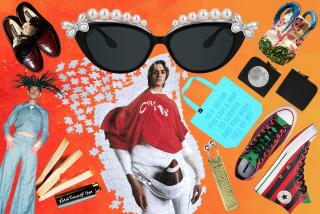Warm words for his cold hometown: Artist celebrates blue-collar Buffalo

Graphic artist Michael Morgulis, 73, of Buffalo, N.Y., is proud of his roots.
There’s a joke out there somewhere — quite a few of them actually — with the bustling, beautiful and sometimes weather-cursed city of Buffalo as the punchline.
But one thing’s for sure: Graphic artist Michael Morgulis isn’t telling it.
At 73, his hair as white as the blowing snow in a Buffalo blizzard, Morgulis is a hometown boy proud of his roots in the place that once billed itself as the “Queen City of the Lakes” but has since fallen on harsh economic times common to Rust Belt cities.
He’s this city’s Andy Warhol: He has made a career of turning a cheek to Buffalo bashers, while creating a line of silk-screened posters and T-shirts that celebrates the city and all of its quirks.
His designs feature the iconic image of a buffalo, or bison, with observations and inside jokes about the city’s people and their decidedly blue-collar point of view.
At his shop, New Buffalo Graphics, one popular work proclaims “Buffalo: City of No Illusions.” There’s a takeoff on the Buffalo Sabres hockey team logo, with the crossed swords replaced by snow shovels. Then there’s his score of “Shuffle Off to Buffalo,” the jaunty song from the 1933 musical “42nd Street.” But in Morgulis’ imagined world, the notes are rendered as tiny buffaloes.
His work often asks: So which Buffalo do you want to espouse? The stereotype of chicken wings and a professional football team that can never seem to win the big game?
Or a city filled with priceless architecture that includes several buildings by Frank Lloyd Wright, with 80 sites listed on the National Register of Historic Places? A place close to Canada and Niagara Falls still ranked among the nation’s top communities to raise a family?
For Morgulis, the answer is obvious.
“Buffalo is not really a big city, but it’s not a small town either,” he said. “It’s built on a human scale.”
Morgulis grew up on the city’s east side, the son of a corner grocer. He recalls walking through leafy turn-of-the-century parks and seeing the Buffalo Bisons, a minor league baseball team, from the bleacher seats.
He was taught that his city originated in 1789 as a trading outpost and exploded after the opening of the Erie Canal in 1825 to become a railroad and grain-milling hub. Its architectural landmarks include the Darwin D. Martin House, an example of Wright’s celebrated Prairie-style vision, and the now closed Buffalo State Asylum for the Insane, with its twin-towered Gothic administration building.
Sure, William McKinley was assassinated here in 1901, but another president, Grover Cleveland, once served as Buffalo mayor and the sheriff of Erie County — and Abraham Lincoln visited Buffalo on his trip to assume the presidency in 1861.
Eventually, Buffalo stumbled: Shipping and rail died. Steel factories closed.
As a young man, with a master’s degree in American studies at the State University of New York at Buffalo, Morgulis relocated to San Francisco, where he studied psychedelic poster art — selling Grateful Dead T-shirts in Golden Gate Park.
By the time he returned to Buffalo in 1975, his city reeled from collapse and bad PR. Comedian Johnny Carson mocked Buffalo for its June blizzards and beer-drinking culture.
By 1990, the population had fallen below its 1960 levels. Only recently has the city, population now about 260,000, enjoyed a renaissance of rebuilding and growth.
People tended to get insecure. Mayor Jimmy Griffin said all the city needed to match the allure of Southern California was to install rows of potted palm trees down Main Street, at least in summer.
It never happened.
But instead of hitting the analyst’s couch, Buffalo developed a series of feel-good slogans: It was the “City of Good Neighbors” and “City of Light.” Buffalonians, as they’re called, were “talking proud” of a community billed as “a friendly place.” And a 2011 campaign simply boasted, “Buffalo: For Real.”
“It’s like people cringed over the weight of living in Buffalo, desperate to believe something good was happening,” Morgulis said. “But in the 1970s, the city was falling apart, with little to feel good about.”
But Morgulis was always more than slogans. Trapped in his studio during the epic blizzard of 1977, Morgulis designed the “City of No Illusions” work, based on the 1967 post-apocalyptic novel “City of Illusions” by Ursula K. Le Guin. After photos of actor Brad Pitt wearing the shirt ran in several magazines, sales soared.
If the city was cool enough for Brad, well then, maybe Buffalo was back. And Morgulis was going to keep celebrating it.
Other artworks followed. A buffalo in rainbow colors and one in a blizzard with the script, “If you don’t like the weather in Buffalo, wait a minute.” There’s a yin and yang image with — you guessed it — buffaloes.
Recently, some wag in town made a T-shirt to tap the resentment of a city never invited to the party. It reads, “Buffalo hates you too.”
That’s just not the Morgulis style. His take is the celebration of this ballsy blue-collar heaven.
“Buffalo is what it is,” Morgulis said. “There really are no illusions. People look at things as they are: No splash. No glitter. Really hard-edged. But the place is beautiful in its own way.”
john.glionna@latimes.com
Twitter: @jglionna
More to Read
Start your day right
Sign up for Essential California for news, features and recommendations from the L.A. Times and beyond in your inbox six days a week.
You may occasionally receive promotional content from the Los Angeles Times.







